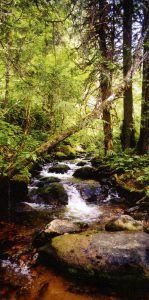
Temperate rainforests generally occur within 100 miles of the Pacific coast where moisture from offshore winds is trapped by mountains. The “wetbelt” forests of the Northern Rockies, however, are the largest known interior rainforests in the world, stretching over 30 million acres from central British Columbia south to the Clearwater Basin of North Central Idaho.
In contrast to the ponderosa and lodgepole pine forests that dominate so much of the Northern Rockies, the Clearwater Basin contains many vascular plant species similar to those in coastal temperate rainforests of Oregon and Washington. These species are known as coastal disjunct.
The origin of Coastal Disjunct species in the Clearwater can be explained by the geological history of our region. The Bitterroot Mountains used to form the western edge of the continent, with moisture extending from the Pacific into the forests of Idaho. When the Cascade Mountains formed, however, they blocked the wet coastal winds from reaching (the now interior) forests. As a result, most of the inland temperate rainforests and many of their associated plant species disappeared, except for scattered sites in southern British Columbia, western Montana and northern Idaho. This helps explain the many endemic and genetically unique populations that have been documented in the Clearwater Basin.
Idaho has the largest and most unique interior rainforest in the world. While moist forests similar to the temperate rainforests of the Pacific Northwest coast were once common in our region, the forests of the upper Lochsa River and the North Fork of the Clearwater River are among the few examples of these forest refugia that remain. While driving along the Lochsa River, one may observe a seemingly endless dense, dark forest of Western red cedar and grand fir. If hiking the N. Fork Clearwater, one can observe thickets of red alder and maidenhair fern, while boaters on the lower Selway may come across Pacific Dogwood.
A good example of a Coastal Disjunct community is the Lochsa Research Natural Area (RNA) established primarily to preserve examples of Pacific Coast vegetation types that occur in very limited sites in Idaho. The RNA contains three different sizes of entrenched streams that feed the Lochsa River. Fourteen different coastal disjunct species occur in the RNA, most of which are riparian. The forest climax type of both streams is western hemlock overstory and ladyfern/maidenhair understory. Western red cedar is also a common overstory species. Such a plant assemblage indicates a warm, nutrient-rich site. Some additional coastal disjunct species include Rocky Mountain maple, buckthorn, Pacific dogwood and red alder.
Another example of a Coastal Disjunct community is the Aquarius Research Natural Area which was established in 1991. It is two miles in length and includes the last free-flowing, unroaded stretch of the N. Fork Clearwater. The site is characterized by relatively warm temperatures, high precipitation, and humidity. The RNA is a microcosm of mostly the lower canyons of the North Fork, Selway, St. Joe and Coeur d’Alene Rivers that also contain an extraordinary assemblage of disjunct and endemic plant and animal taxa together with unique vegetation types. The RNA also contains unidentified species of earthworms, terrestrial beetles, and contrasting macro-invertebrate communities from tributary streams on both sides of the North Fork. Such ecosystems occur nowhere else east of the Cascades.
Click here to see pictures of the Aquarius Research Natural Area.
Click here to learn more about Research Natural Areas.